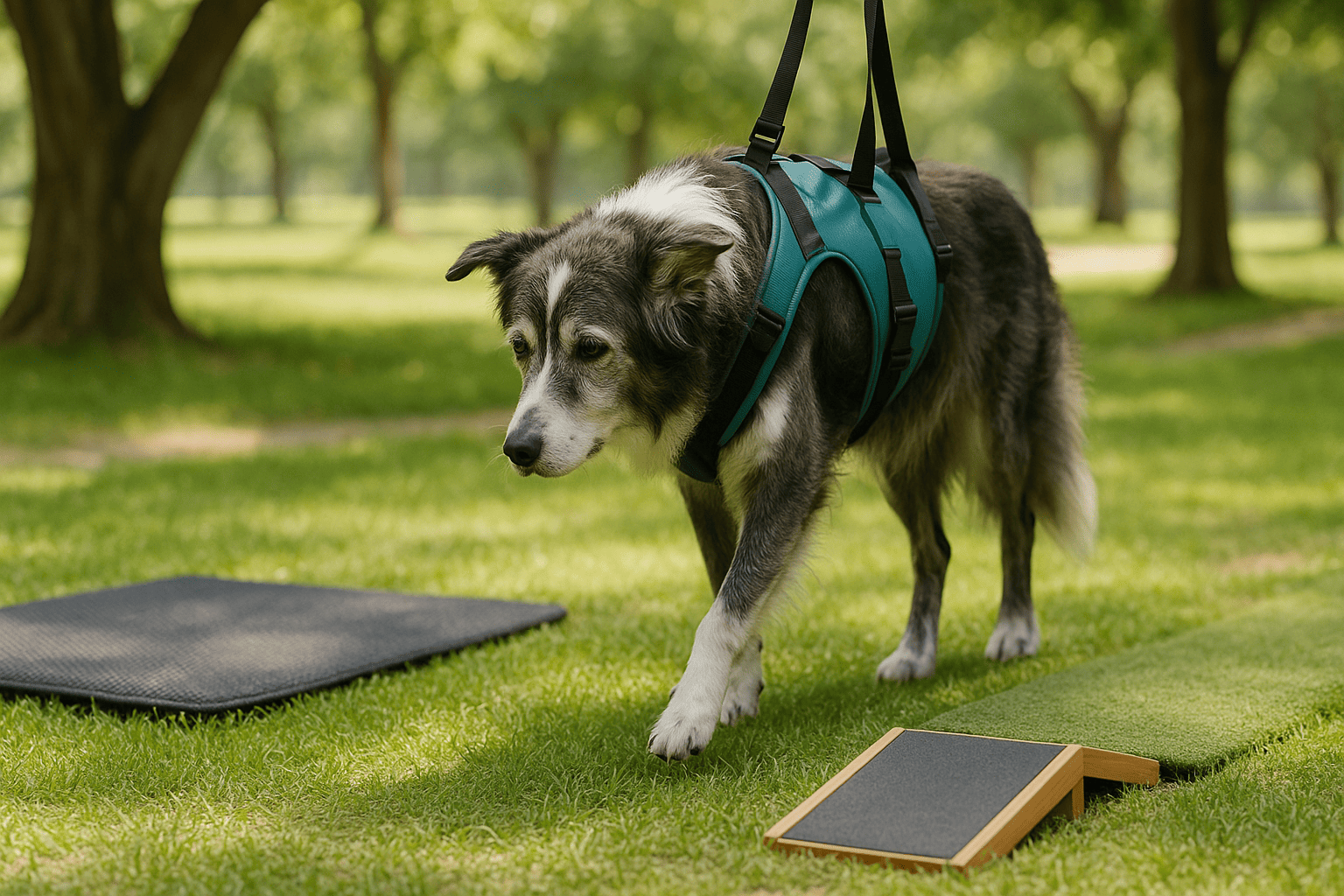Introduction
Arthritis is a prevalent condition in senior dogs, causing joint inflammation, pain, and stiffness that limit mobility and daily activities. While staying active is crucial for maintaining muscle strength, circulation, and mental well-being, exercising dogs with arthritis requires careful planning to avoid injuries.
Safe, low-impact routines can enhance your dog’s quality of life without worsening joint pain. This article shares practical tips to exercise your arthritic dog safely, from choosing the right surfaces to using supportive gear. For complementary activities, explore our guide on safe walks for senior dogs with arthritis to keep your dog moving comfortably.
Know Your Dog’s Limits
Understanding your dog’s physical limits is the foundation of safe exercise for dogs with arthritis. Arthritis varies in severity, and each dog responds differently to activity. Recognizing signs of discomfort is key to preventing injuries.
- Common Pain Indicators: Limping, stiffness, reluctance to move, whining, or behavioral changes like irritability.
- How to Respond: If your dog limps or hesitates, stop the activity and allow rest. Shorten sessions or adjust intensity based on their reactions.
Avoid high-impact activities like running or jumping, which strain joints. Instead, opt for gentle movements, such as short walks or light stretching, to promote mobility safely. Regular observation ensures exercises align with your dog’s comfort, keeping them active without harm.
Choose the Right Surfaces
The surface your dog exercises on significantly impacts joint safety. Soft, non-slip surfaces reduce strain and prevent injuries for dogs with arthritis.
- Ideal Surfaces: Grass, carpet, or rubber mats cushion steps and provide traction, minimizing joint impact.
- Surfaces to Avoid: Hard floors (tile, laminate) or stairs increase slipping risks and joint stress.
For indoor exercise, place non-slip rugs or mats in high-traffic areas. Outdoors, choose grassy parks or dirt trails over concrete sidewalks. If stairs are unavoidable, install ramps to ease movement. These adjustments create a joint-friendly environment, boosting your dog’s confidence and safety during activity. For more low-impact ideas, check our guide on stretching for senior dogs.
Supportive Equipment
Supportive gear enhances safety and comfort during exercise, reducing strain on arthritic joints.
- Ramps: Use portable or fixed ramps for accessing furniture or cars, eliminating the need to jump.
- Harnesses: Chest or back-support harnesses distribute weight evenly, improving stability and reducing leg strain during walks.
- Non-Slip Mats: Place cushioned mats or runners in hallways or play areas to prevent slips, especially on slick floors like hardwood.
These tools encourage safe movement and minimize injury risks. For example, a padded harness can make short walks more comfortable, while ramps simplify daily routines. Investing in such equipment supports your dog’s mobility and enhances their exercise experience.
Low-Impact Exercises
Low-impact exercises are ideal for dogs with arthritis, promoting health without overexertion. These activities strengthen muscles and improve circulation while protecting joints.
- Short, Frequent Walks: Break walks into 5–10-minute sessions multiple times daily on flat, soft surfaces like grass. This maintains mobility without fatigue.
- Gentle Stretching: Perform light stretches, such as extending front legs or massaging tense areas, to ease stiffness. Consult a vet for safe techniques.
- Supervised Swimming: Swimming is a top low-impact exercise, as water’s buoyancy reduces joint pressure while building muscle. Ensure warm water (82–90°F or 28–32°C) and supervision. Learn more in our article on therapeutic swimming.
These exercises improve physical and mental wellness, helping your dog stay active and pain-free.
Include Rest Breaks
Frequent rest breaks are essential to prevent overloading arthritic joints during exercise.
- Timing: Pause every 10–15 minutes during walks or play to let your dog rest and recover.
- Recovery Periods: For intense activities like swimming, allow 24–48 hours between sessions to avoid muscle or joint strain.
- Benefits: Breaks reduce fatigue, prevent injuries, and make exercise more enjoyable.
Monitor your dog’s energy levels during breaks. If they seem tired or sore, shorten the next session. This approach ensures exercise remains sustainable and safe.
Veterinary Supervision and Physical Therapy
Veterinary oversight is critical for safe exercise routines for dogs with arthritis.
- Veterinary Evaluation: A vet can assess joint health, recommend suitable activities, and suggest supplements or medications to manage pain.
- Physical Therapy: Veterinary physiotherapists offer low-impact therapies like hydrotherapy or guided stretching to improve strength and reduce stiffness.
- Personalized Plans: Collaborate with a vet or physiotherapist to create a tailored exercise plan, including home activities and professional sessions.
Regular check-ups ensure your dog’s routine evolves with their needs, maximizing benefits and minimizing risks.
Frequently Asked Questions
How much exercise is safe for my arthritic dog?
Start with 5–10-minute sessions 2–3 times daily, adjusting based on your dog’s response. Consult your vet for a personalized plan.
Can I exercise my dog indoors?
Yes, use non-slip mats and low-impact activities like gentle stretching or scent games. Indoor ramps can also help with mobility.
What if my dog refuses to exercise?
Respect their signals and try gentler activities, like short walks or treat-based games. A vet can check for underlying pain or issues.
Conclusion
Exercising dogs with arthritis safely is key to maintaining their health and happiness. By understanding their limits, choosing soft surfaces, using supportive equipment, opting for low-impact exercises, including rest breaks, and seeking veterinary guidance, you can create a routine that protects joints and enhances well-being.
Observe your dog’s reactions and adjust as needed to ensure comfort. With these tips, your furry friend can stay active, mobile, and pain-free, enjoying a fulfilling life despite arthritis. Share your experiences in the comments!

